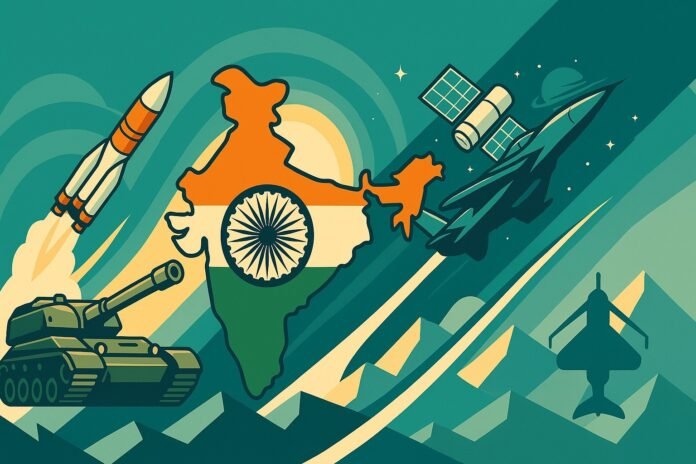India, the world’s largest democracy, gears up to celebrate the 79th anniversary of Independence Day, a hallowed event. It was the culmination of indefatigable struggle, toils, tears, and sweat of our heroes that we are today living, breathing, and experiencing liberty. On August 15, 1947, we pledged to transform the lives of our people for the better, to become stronger, and to become a developed nation that would lead the world in forging a new global order governed by the principles of peace, equity, tolerance, and inclusiveness.
Seventy-nine years down the line, while we have made giant strides, much remains to be done. One such area of progress in India is innovation and technology. India of today has emerged as a technology and innovation powerhouse, becoming one of the world’s largest exporters of IT-oriented services. Almost every facet of an Indian’s life is governed by technology. It is in that context that we need to take a stock of India’s status as an innovation nation and technology powerhouse, especially from the prism of national security.
India today is the world’s fourth most powerful military; we possess in our arsenal one of the world’s largest armies and a formidable air force, navy, and coast guard. We also have the distinction of possessing the world’s largest para-military force. We also have a multiplicity of internal and external security agencies to guard the country’s internal and external borders.
Innovation & Technology
Being a country of over 140 million people and one of the largest skilled and semi-skilled labour forces in the world, innovation has become an integral part of India’s smart power reservoir.
In the field of defence and national security, India has made meaningful strides. Integration of technology has become an integral part of the operational repertoire of the armed forces and intelligence agencies.
INS Vikrant, India’s largest warship, is a towering symbol of the indigenisation of technology, with 70% indigenous content. The Tejas fighter jet is another glorious asset protecting our skies
India has made notable progress in this regard; for instance, INS Vikrant, India’s largest warship, is a towering symbol of the indigenisation of Indian technology. The indigenous content in it is over 70%. Further, the Tejas fighter jet is another glorious asset protecting our skies. In small arms, ASMI is an Indian innovation in the field of submachine guns that has been developed by the Armament Research and Development Establishment of the DRDO, which has been inducted into the armed forces for use by the parachute regiment of the Indian Army.
The military-industrial complex, which involves the participation and collaboration between the public sector enterprises and the private sector, is spearheading this innovation drive. HAL, BHEL, and DRDO’s efforts are being supplemented by those of Tata Defence, L&T, Adani Defence, to name a few.
Transfer of Technology and joint production are other key aspects of India’s innovation drive in the defence sector. The BRAHMOS supersonic cruise missile is an excellent example of an Indo-Russian joint initiative. The hypersonic version of this missile is currently under joint development. The BRAHMOS is one of the many Indian defence assets that have attracted global interest in their acquisition.

Operation Sindoor demonstrated, very clearly, the changing dimensions of warfare in India, especially the importance of new munitions. Recognising its importance, India is actively pursuing the creation of loitering munitions. As Operation Spider Web of Ukraine demonstrated, loitering munition is the next big thing on the battlefield. India, in that context, is actively pursuing the production of loitering munitions, or the kamikaze drones. India already possesses the SkyStriker drone with a range of 500 km in its arsenal. Further, companies such as ZMotion Autonomous Systems and Tata Advanced Systems are testing their loitering munitions.
Any description of Indian innovation in the field of national security would be incomplete without incorporating space and critical minerals. In the realm of space, ISRO is doing a commendable job in production, launching, and putting into orbit a multiplicity of spy satellites such as RISAT-2B, RISAT-2BR1, and RISAT-1B (EOS-09). These satellites constitute the backbone of India’s satellite intelligence capabilities, serving as India’s eye in the sky.
Acutely low funds for R&D are a key issue. A lack of institutional strengthening cannot create a conducive environment for bright young minds. An ecosystem that takes into account spending and institutional factors is the need of the hour
India, which is well-endowed with several minerals, is unfortunately deficient in several critical minerals, such as silicon, molybdenum, lithium, cobalt, and copper. To address this issue, the Union government recently launched the National Critical Minerals Mission (NCMM). Further, Prime Minister Narendra Modi’s diplomatic visits to Argentina, Ghana, and other nations as a part of a marathon diplomatic outreach was meant to forge stronger ties with these countries, which have high reserves of critical minerals like copper, cobalt, and lithium, which are essential for manufacturing various electronic devices, car parts to name a few.
Shortcomings
Despite important achievements, it is essential to present a balanced picture of the innovation and technology story. A key issue with Indian innovation and technological development is that most of the brightest minds are those who hail from the Indian Institutes of Technology (IIT) and National Institute of Technology (NIT). Contributions in the field of innovation and technological development are found abysmally lacking from the Tier 2 & Tier 3 institutions.

Another key issue is acutely low spending on Research and Development (R&D), a paltry 0.64% of its GDP, compared to 2.4% of China and 3.5% of America. Low spending on R&D and a lack of institutional strengthening and enforcement will not create an environment conducive to bright young minds. An amicable enabling ecosystem that takes into account both spending and institutional factors is the need of the hour.
Another major problem is the poverty of aspirations in India; the lack of proper creation of well-paying jobs is stifling the ambitions and entrepreneurial mindset of Indians, especially those from Tier-3 and Tier-4 cities. It is imperative that like-minded stakeholders in India, from the government to the private sector, play a decisive role in creating an ecosystem that would allow the innovative thought process of India’s youth to thrive.
A glaring shortcoming in India’s technology and innovation story is the disconnect between industry, academia, and the defence establishment. Students must have a strong connection with industry and military services
Another shortcoming in India’s technology and innovation story is the ostensible disconnect between industry, academia, and the defence establishment. In the changing age of warfare, where the contours of national security and safety are undergoing rapid transformation, it is essential to ensure that the education of young, impressionable minds has practical utility, not just empty theories. Students in schools and colleges, in every corner of India, must have a strong connection with industries and the defence establishment to learn while working. This will play a critical role in enabling those who want to join the armed forces, become entrepreneurs, or join the civil services, to bring domain expertise to the table.
Despite these shortcomings, policy and sectoral establishments must form hybrid strategies that can solve the problems plaguing our innovation and technological ecosystem. This is an important measure to shed bureaucratic inertia to promote e-governance.
As we celebrate the 79th anniversary of our Independence Day, we must take a collective pledge to not only work to improve the official settings but also to improve ourselves as citizens; it is only through a vigilant and patriotic citizenry that a country can flourish.
–The writer is currently working as a Research Associate at Defence Research and Studies (dras.in) and is a columnist. The views expressed are personal and do not necessarily reflect the views of Raksha Anirveda






